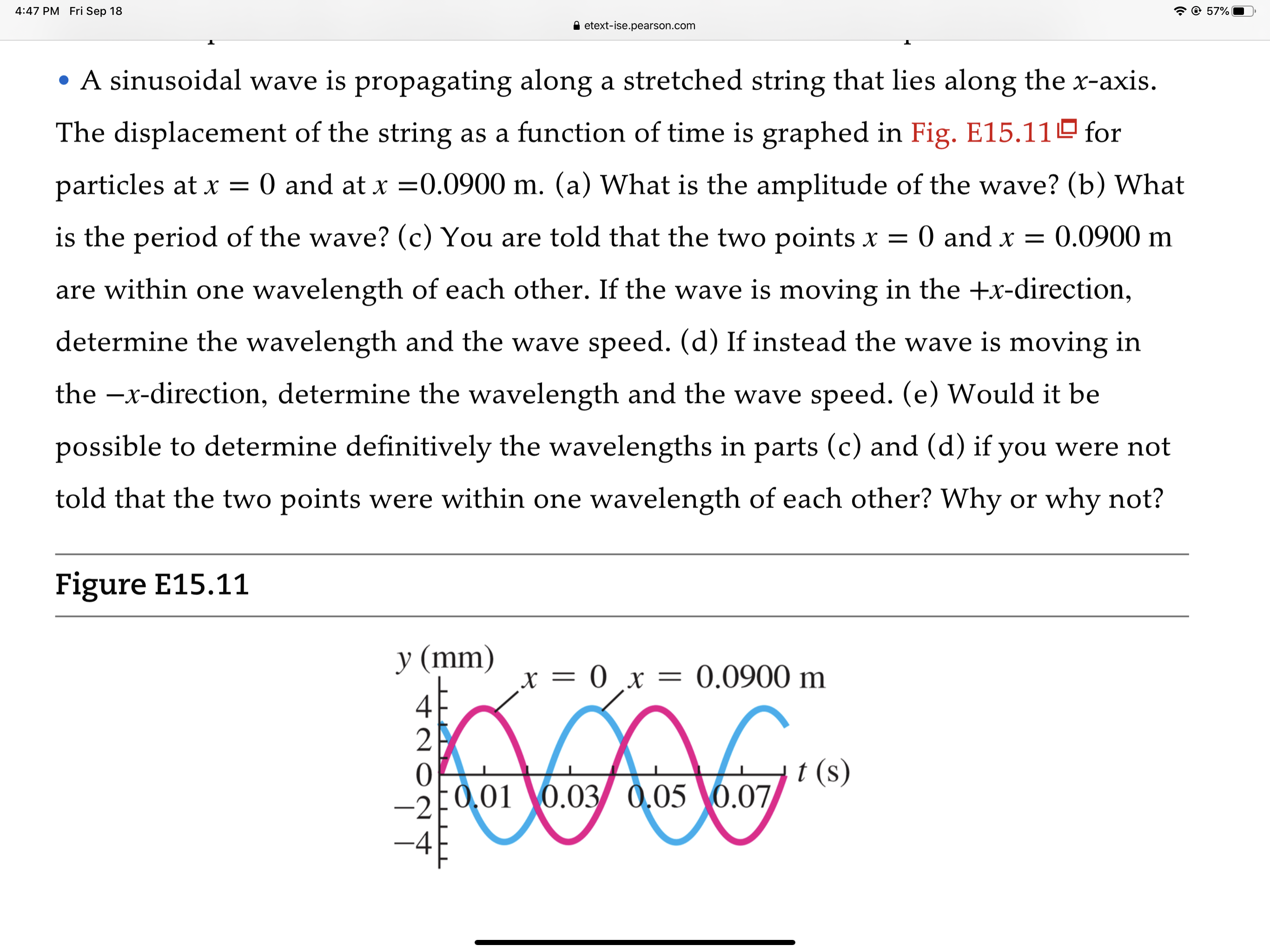• A sinusoidal wave is propagating along a stretched string that lies along the x-axis. The displacement of the string as a function of time is graphed in Fig. E15.11º for particles at x = O and at x =0.0900 m. (a) What is the amplitude of the wave? (b) What is the period of the wave? (c) You are told that the two points x = O and x = 0.0900 m are within one wavelength of each other. If the wave is moving in the +x-direction, determine the wavelength and the wave speed. (d) If instead the wave is moving in the –x-direction, determine the wavelength and the wave speed. (e) Would it be possible to determine definitively the wavelengths in parts (c) and (d) if you were not told that the two points were within one wavelength of each other? Why or why not?
• A sinusoidal wave is propagating along a stretched string that lies along the x-axis. The displacement of the string as a function of time is graphed in Fig. E15.11º for particles at x = O and at x =0.0900 m. (a) What is the amplitude of the wave? (b) What is the period of the wave? (c) You are told that the two points x = O and x = 0.0900 m are within one wavelength of each other. If the wave is moving in the +x-direction, determine the wavelength and the wave speed. (d) If instead the wave is moving in the –x-direction, determine the wavelength and the wave speed. (e) Would it be possible to determine definitively the wavelengths in parts (c) and (d) if you were not told that the two points were within one wavelength of each other? Why or why not?
Principles of Physics: A Calculus-Based Text
5th Edition
ISBN:9781133104261
Author:Raymond A. Serway, John W. Jewett
Publisher:Raymond A. Serway, John W. Jewett
Chapter14: Superposition And Standing Waves
Section: Chapter Questions
Problem 4P
Related questions
Question

Transcribed Image Text:• A sinusoidal wave is propagating along a stretched string that lies along the x-axis.
The displacement of the string as a function of time is graphed in Fig. E15.11º for
particles at x =
O and at x =0.0900 m. (a) What is the amplitude of the wave? (b) What
is the period of the wave? (c) You are told that the two points x =
O and x = 0.0900 m
are within one wavelength of each other. If the wave is moving in the +x-direction,
determine the wavelength and the wave speed. (d) If instead the wave is moving in
the –x-direction, determine the wavelength and the wave speed. (e) Would it be
possible to determine definitively the wavelengths in parts (c) and (d) if you were not
told that the two points were within one wavelength of each other? Why or why not?
Expert Solution
This question has been solved!
Explore an expertly crafted, step-by-step solution for a thorough understanding of key concepts.
This is a popular solution!
Trending now
This is a popular solution!
Step by step
Solved in 4 steps with 1 images

Knowledge Booster
Learn more about
Need a deep-dive on the concept behind this application? Look no further. Learn more about this topic, physics and related others by exploring similar questions and additional content below.Recommended textbooks for you

Principles of Physics: A Calculus-Based Text
Physics
ISBN:
9781133104261
Author:
Raymond A. Serway, John W. Jewett
Publisher:
Cengage Learning

University Physics Volume 1
Physics
ISBN:
9781938168277
Author:
William Moebs, Samuel J. Ling, Jeff Sanny
Publisher:
OpenStax - Rice University

Physics for Scientists and Engineers, Technology …
Physics
ISBN:
9781305116399
Author:
Raymond A. Serway, John W. Jewett
Publisher:
Cengage Learning

Principles of Physics: A Calculus-Based Text
Physics
ISBN:
9781133104261
Author:
Raymond A. Serway, John W. Jewett
Publisher:
Cengage Learning

University Physics Volume 1
Physics
ISBN:
9781938168277
Author:
William Moebs, Samuel J. Ling, Jeff Sanny
Publisher:
OpenStax - Rice University

Physics for Scientists and Engineers, Technology …
Physics
ISBN:
9781305116399
Author:
Raymond A. Serway, John W. Jewett
Publisher:
Cengage Learning

Physics for Scientists and Engineers
Physics
ISBN:
9781337553278
Author:
Raymond A. Serway, John W. Jewett
Publisher:
Cengage Learning

Physics for Scientists and Engineers with Modern …
Physics
ISBN:
9781337553292
Author:
Raymond A. Serway, John W. Jewett
Publisher:
Cengage Learning

College Physics
Physics
ISBN:
9781938168000
Author:
Paul Peter Urone, Roger Hinrichs
Publisher:
OpenStax College